As the 2020/21 season draws to an end, We will be witnessing the Euros 2020 take place this summer after it got postponed from its original date due to the pandemic. The shift meant that every team had exactly a year to get prepared for the bigger stages especially for those who qualified just a few months before the summer of 2020. The Hungary football team is one such team that would be hugely benefited from the fact that it got delayed as they have had ample amount of time to prepare themselves.
In 2016, they took everyone by surprise when they topped their group that contained the then champions Portugal and another good team in Austria. Though they were humbled to a 4-0 defeat by Belgium, they would look to replicate the same. But this time instead of Austria and Iceland they will lock horns with World Champions France and 2014 WC champions Germany along with the defending champions Portugal, who look even stronger compared to last time.
It will certainly be difficult in the group of death with the presence of the mentioned teams. In this tactical analysis, in the form of a scout report, we will be discussing Hungary’s tactics and their playing style. Let’s begin the analysis.
THE SQUAD
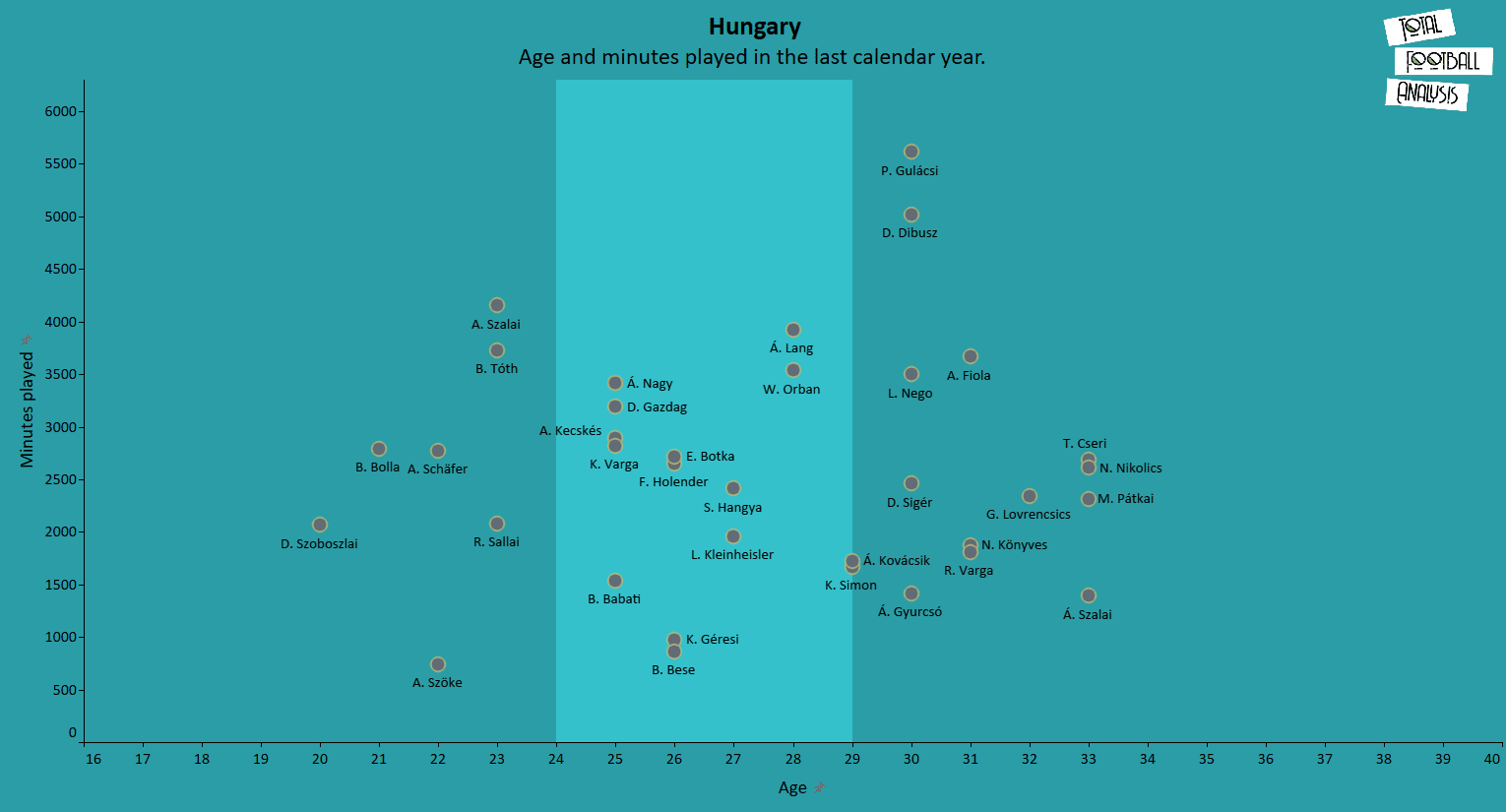
Hungary have a very good number of players in their peak years to choose from. The peak years we have seen to be fit for a footballer is from 24-29 years of age. We can see some quality players like Willi Orban, Adam Lang, Szilveszter Hangya, Nagy, etc come in this bracket. Most of the players in their peak have also played a good amount of minutes in the last calendar year. They also have some good young talents like Attila Szalai and Roland Sallai who impressed in their recent 3-3 draw against Poland. Szoboszlai is one of their brightest ones though he has featured very less this season for both club and country owing to injuries.
The probable squad might also contain a lot of veterans and 30+ players with some prominent names like Fiola, Adam Szalai, Lovrencsics, Nikolics, etc. These players have humongous experience playing at the top level for both club and country. Analyzing deeper with respect to each position we see that they have a good balance in the defensive area. So Marco Rossi will have a good amount of options to choose from and assemble the team.
In the midfield department, they have a lot of players playing in their peak years. The likes of Nagy, Kalmar, Siger and Kleinheisler are all in their peak years currently. So this is another department where Hungary seems to have it covered.
Their forward department seems to have some good experienced players like Szalai, Nikolics and Cseri while also the likes of Geresi and Sallai can instil some freshness and energy into the attack. But this where there seems to be an imbalance as they don’t have someone in their peak years in the squad. Though Geresi is 26, he has played very few minutes at both club level and has made only one senior appearance for his national team. This lack of balance, when compared to the other departments, could be an issue since the young players’ inexperience means they might fail to step up at the right moments and the old legs of Szalai and Nikolics might also mean that they might not be able to make a substantial impact for a run of games especially against the quality of the team present in their group. Also, the likes of Szalai played very few minutes last year and the lack of match practice this season might also be an issue for Rossi in the main stage. Apart from this, they have a very good goalkeeper in the form of Gulacsi who is a constant presence for RB Leipzig.
Below, is the probable 26-man squad that Hungary will be taking to Euro 2020:
Goalkeepers:
Denes Dibusz
Peter Gulacsi
Balazs Toth (Puskas Akademia)
Defenders:
Bendegúz Bolla
Endre Botka
Attila Fiola
Szilveszter Hangya
Akos Kecskes
Adam Lang
Gergo Lovrencsics
Loic Nego
Willi Orban
Attila Szalai
Midfielders:
Tamas Cseri
Daniel Gazdag
Laszlo Kleinheisler
Adam Nagy
Roland Sallai
David Siger
Dominik Szoboszlai
Roland Varga
Forwards:
Filip Holender
Nemanja Nikolic
Szabolcs Schön
Adam Szalai
Kevin Varga
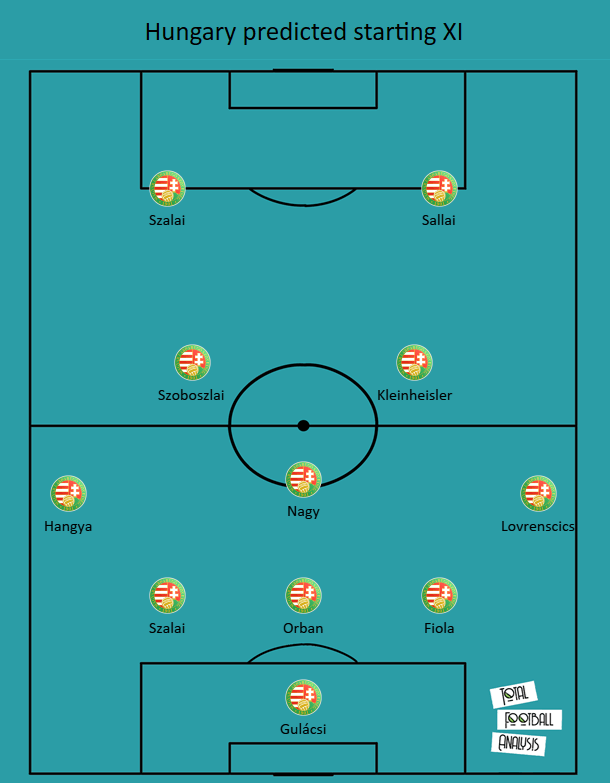
As we have seen the potential players capable of going to the Euros, let’s look into the starting lineup which is given in the above image. Gulacsi is a no-brainer in front of the goal. Ahead of him in a 3-5-2 formation, which Rossi has preferred, are the 3 centre-backs Orban, Attila Szalai and Fiola. The 3 of them have started a good amount of games for Hungary together and their combination is going to be very important for Hungary’s chances. They will most likely be joined by wing-backs Hangya and Lovrenscics responsible for providing width and defending against the opposition wingers. The case can also be made for Botka but Lovrenscisc’s experience could prove to be very vital in the right wing-back position. The probable 3-men midfield combination will feature Nagy at defensive midfield pivot, Szoboszlai as a left central midfielder and Kleinheisler as his counterpart on the right. We have gone with a strike partnership of Szalai and Roland Sallai as the youthful energy of the latter and the experience of the former would be the perfect combination. More tactical and statistical details about the team will be discussed in the following sections.
ATTACKING PHASE
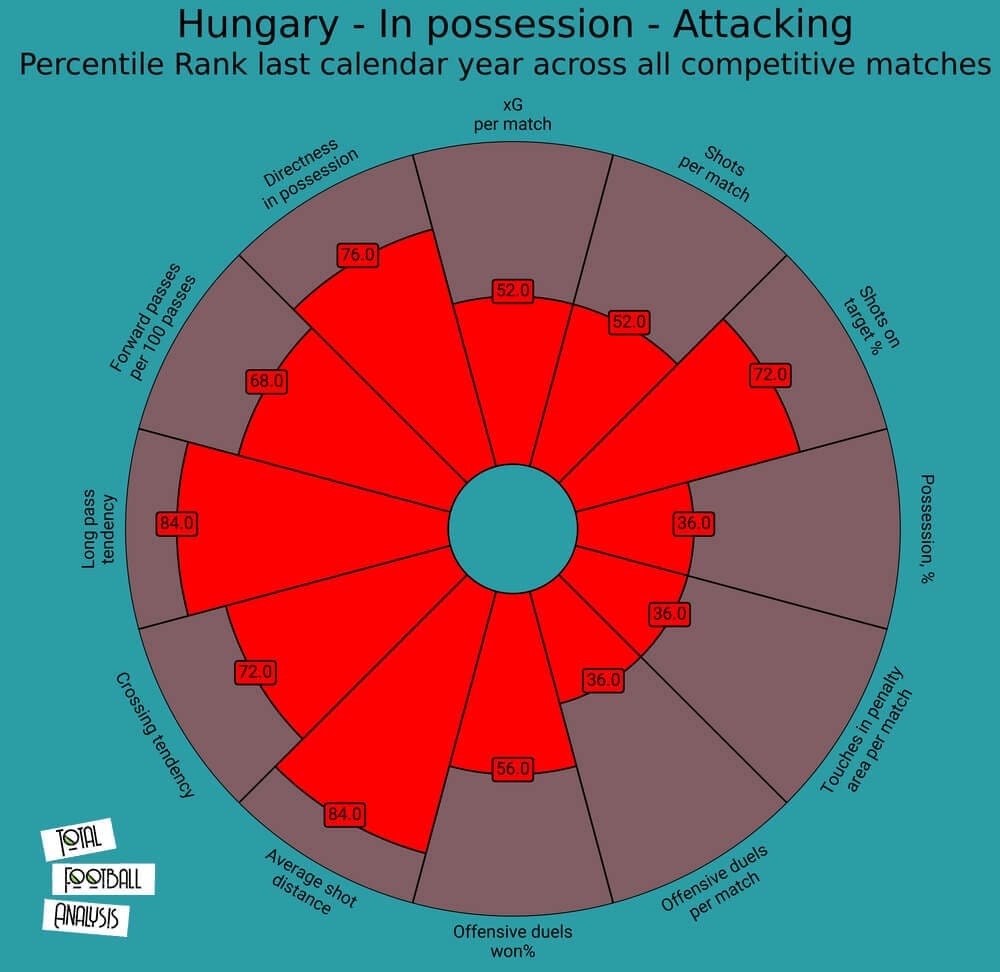
During possession, we can see from the chart that Hungary are not a possession dominant team as they only have a 36th percentile rank. They are very direct in their approach and would like to directly enter the final third with long balls. This can be inferred from the chart where they are at an 84th percentile in terms of long pass tendency and 76th in terms of directness.. This means a good share of their passes are long balls. Since they deploy a wing-back system (3-4-3 or 3-5-2 formations) rely on crosses for their chance creation. Very less possession means they don’t always create opportunities to have offensive duels which is why they have just a 36th percentile rank.
They have a 72nd percentile rank in crossing tendency showing that they use crosses a lot compared to most European teams. Their forward passes per match are high because due to their directness in play that means long-balls from goalkeepers or centre-back to forwards are constantly seen which skews the value.
Inside the final third, they are known to be very threatening. Despite averaging very few touches inside the penalty area, they generated more shots and better quality shots than an average European team playing in Euros this year. Along with that, they are very clinical with their shots too as most of their shots end up on target and tests the goalkeeper. Their strikers and advanced midfielders take most of their shots with the wing-backs too playing second fiddle to them.
Delving deep into their structure, Their usage of a 3-man backline means that their wing-backs Hangya, Lovrencsics, etc are given the freedom to provide width in the final third of the pitch and stay high. We can see that in the image below where Hungary’s 3-man backline is shown. Most teams in Europe at club level use 3 men to play out from the back since teams that press do not commit more than 2 men upfront and those 3 are enough to create a numerical advantage against the opposition. The image is also one of the less often played games where Hungary faced a much weaker opposition and were allowed to score the team’s goal to play out from the back.
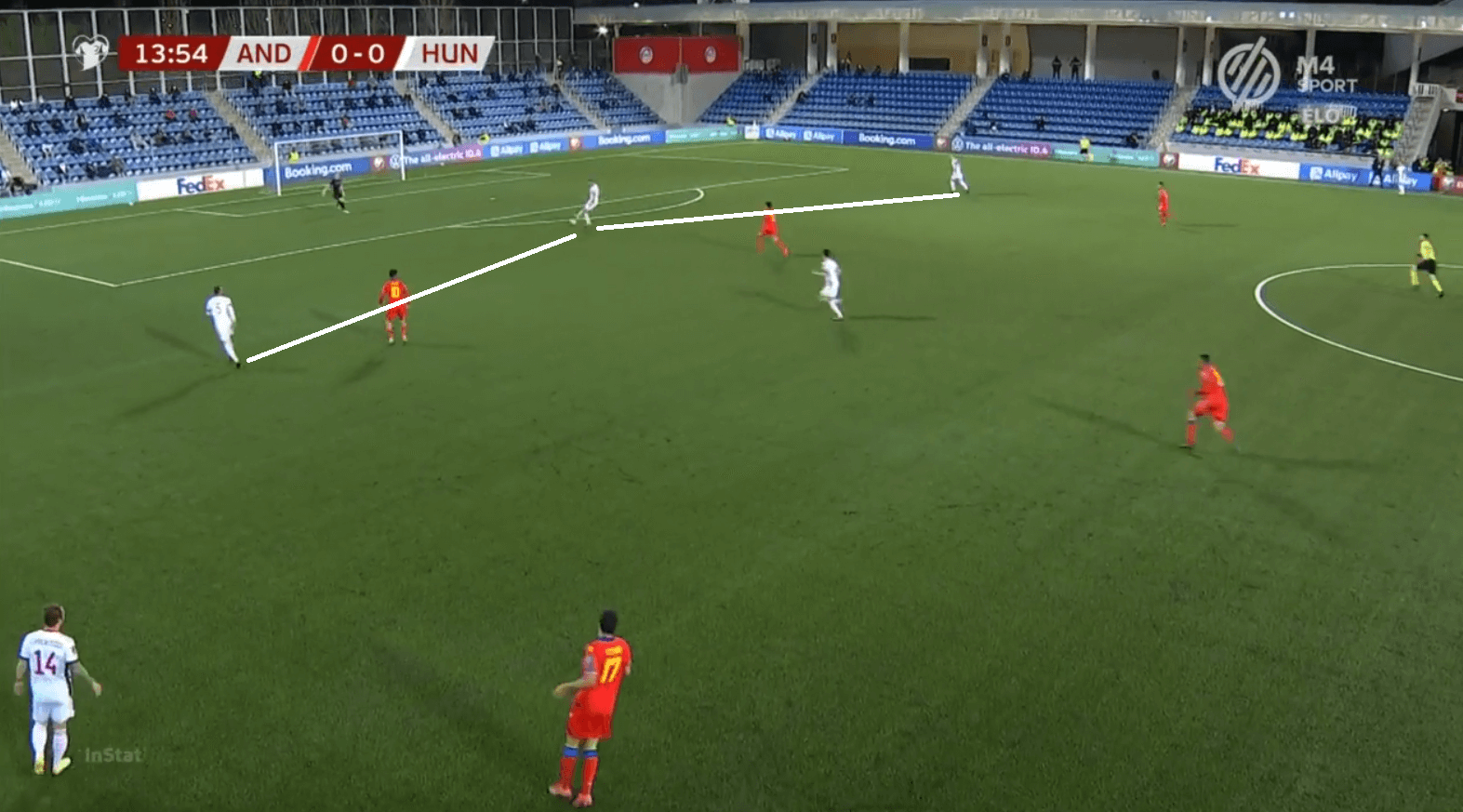
Mostly they would deliver long balls to their strikers from deep and the second balls would be won by the midfielders and they would immediately ping a pass into the final third. But they are capable of playing from the back too when they look to draw opposition to one of the flanks and look to switch it to the far sided flank for progression. An example of that can be seen in the image below, where the wing-back and centre-back have drawn the Andorra players and when Nikolics (the striker) drops, he drags two Andorra players with him and receives a wall pass. His wall pass is then bounced to Kalmar (circled white) who then immediately shifts the ball to the right flank where the wing-back now has acres of space to run. Szalai is also another player who can drop and looks to help his team create numerical advantages in the midfield. This would mean that a defender would follow him by vacating his space. Space can then be attacked by the likes of Sallai, whose pace and skills can cause a lot of issues for the opposition’s defence.
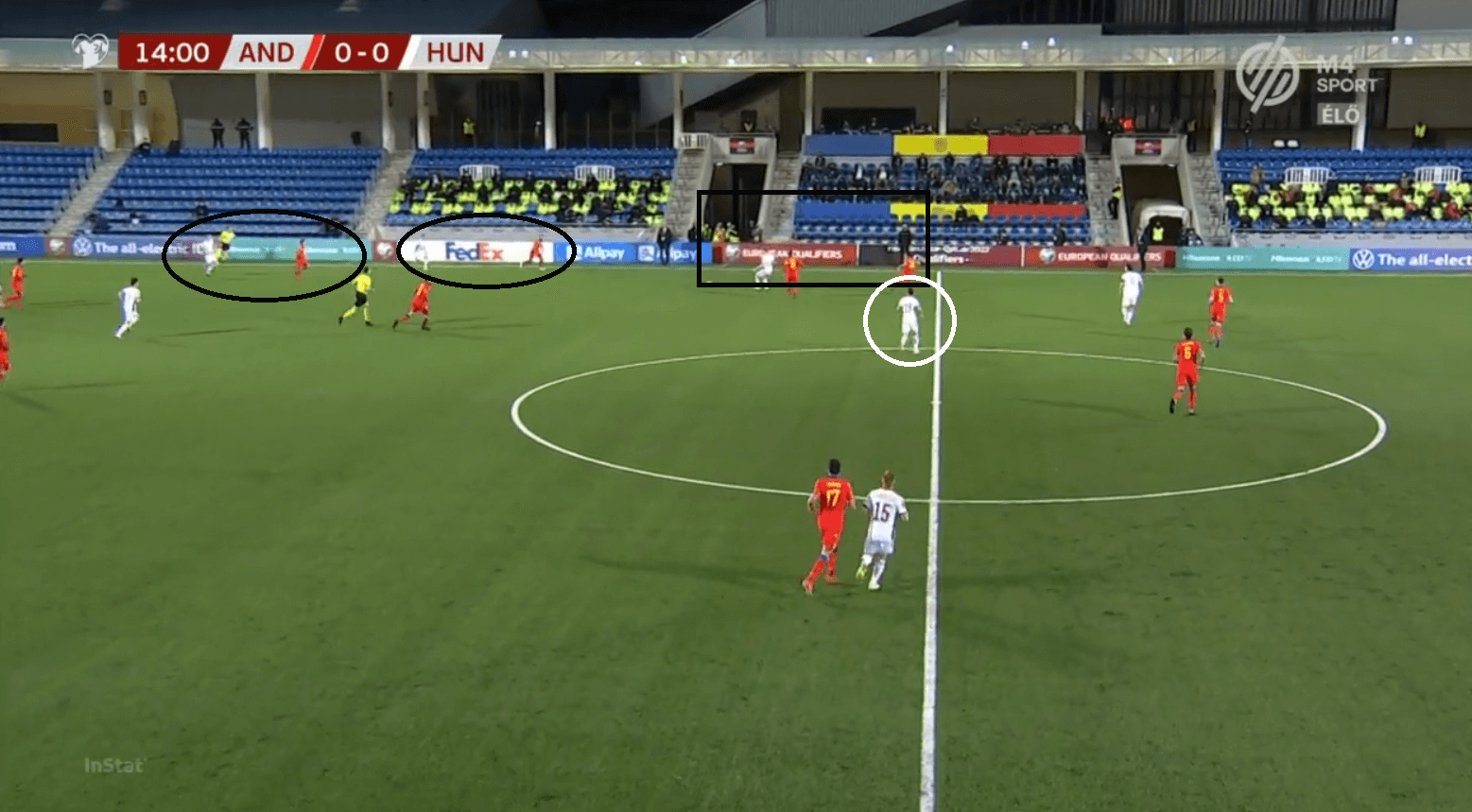
It will be interesting to see their attack against the likes of Germany, France and Portugal in the group stage. All the aforementioned teams are one of the favourites to win the tournament and would demand a lot of possession. This means that the Hungary attack would play on the counter from where they would look to create issues and especially we have seen Germany’s struggles against counter-attacking opposition in recent years. Also they need to be at their clinical best in each of their games, since playing in a low-block, which they are certain to play, might see very few chances come for them.
DEFENSIVE PHASE
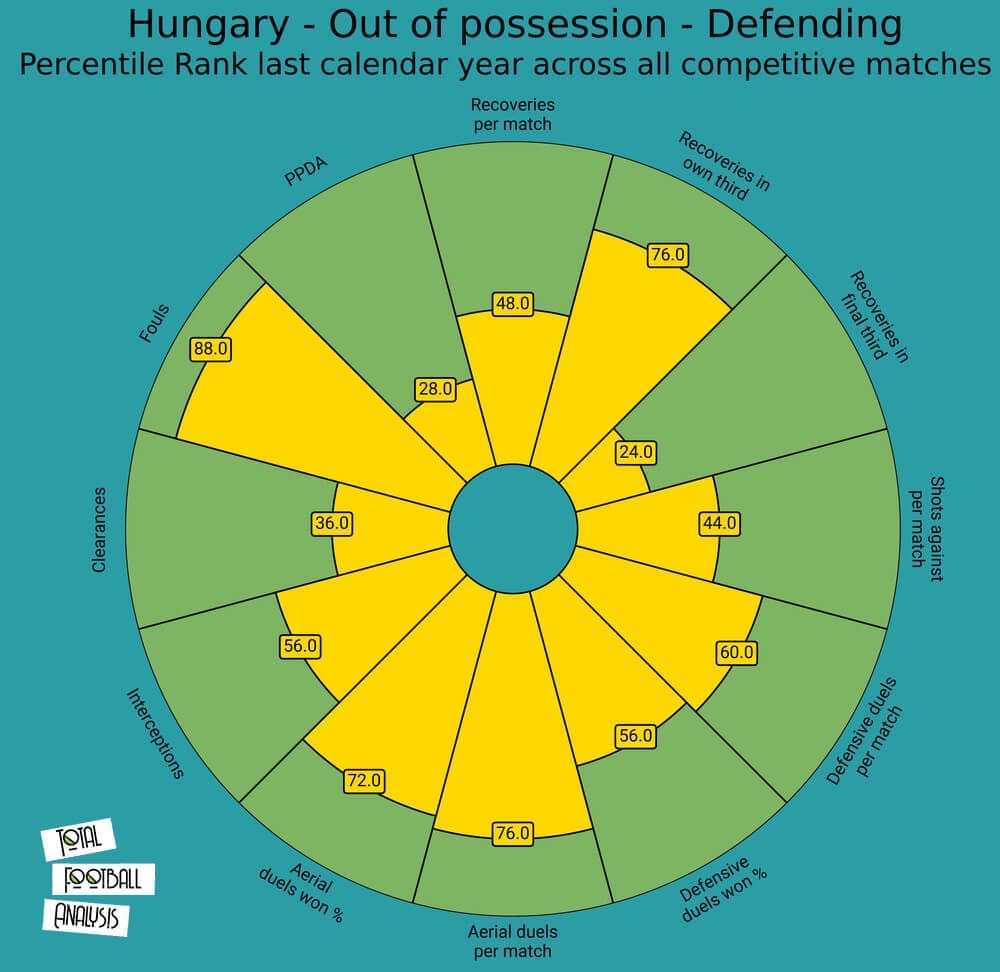
Hungary, as we discussed, line up in a 3-5-2 formation which shifts into a 5-3-2 formation as the wing-backs aid the centre-backs by going deeper. Historically, 5-3-2 also is commonly used by many low-block teams that look to compress the space for the forwards with additional defenders to defend the box. We can see Hungary’s defensive statistics as they rank above the 50th percentile in most of the metrics.
They have a very low PPDA (Passes per defensive action), which is the number of passes allowed by a team per every defensive action they make in their final two-thirds of the pitch, with a rank of 28. This means a low PPDA and Hungary are one of the most intense teams. But delving deeper we see that they make very few recoveries in the final third and a very high amount in their third. So they make a good amount of defensive actions in the middle third that impacts the PPDA. Due to their intensity, they also concede a lot of fouls where some of them can be deemed as unnecessary.
Looking into their defensive duels, they contest a good amount of them per game and also have a win percentage that is more than half the team playing in Euros. They also intercept well with a percentile rank of 56 and some of their defenders like Willi Orban and Adam Lang are very good at reading and anticipating plays and make good interceptions. They also make fewer clearances suggesting that they mostly look to play passes to their players when they intercept the ball and since clearances happen mostly in the 18-yard box or near the touchline, we can say Hungary are very proactive in these situations and look to retain possession.
The most impressive aspect of their defensive side is their overall aerial ability. They are a very good team in the air and probably one of the best going into the tournament. Even though they contest a lot of duels they win most of them with a percentile rank of 72 in terms of aerial duels won. This talks a lot about their sturdy approach and a rigid defence that can sustain crosses and long-balls during a match. A hallmark of a great team is to concede very less shots per match. Hungary seems to be conceding fewer shots per game than an average European team, which shows they are extremely difficult to score against.
Despite being a mid-block team, they also set out to press higher up the pitch especially in their initial minutes. We can see their press against Andorra when they press in a 3-5-2 system in the below image. With Andorra using a 3 man to create a numerical superiority, Hungary are shrewd in forcing the ball out wide. Then immediately their wing-back presses with intensity and forces a turnover. Also, we can see how they have shifted as a team towards the flank while their midfield trio have also kept control over the coverage in the centre.
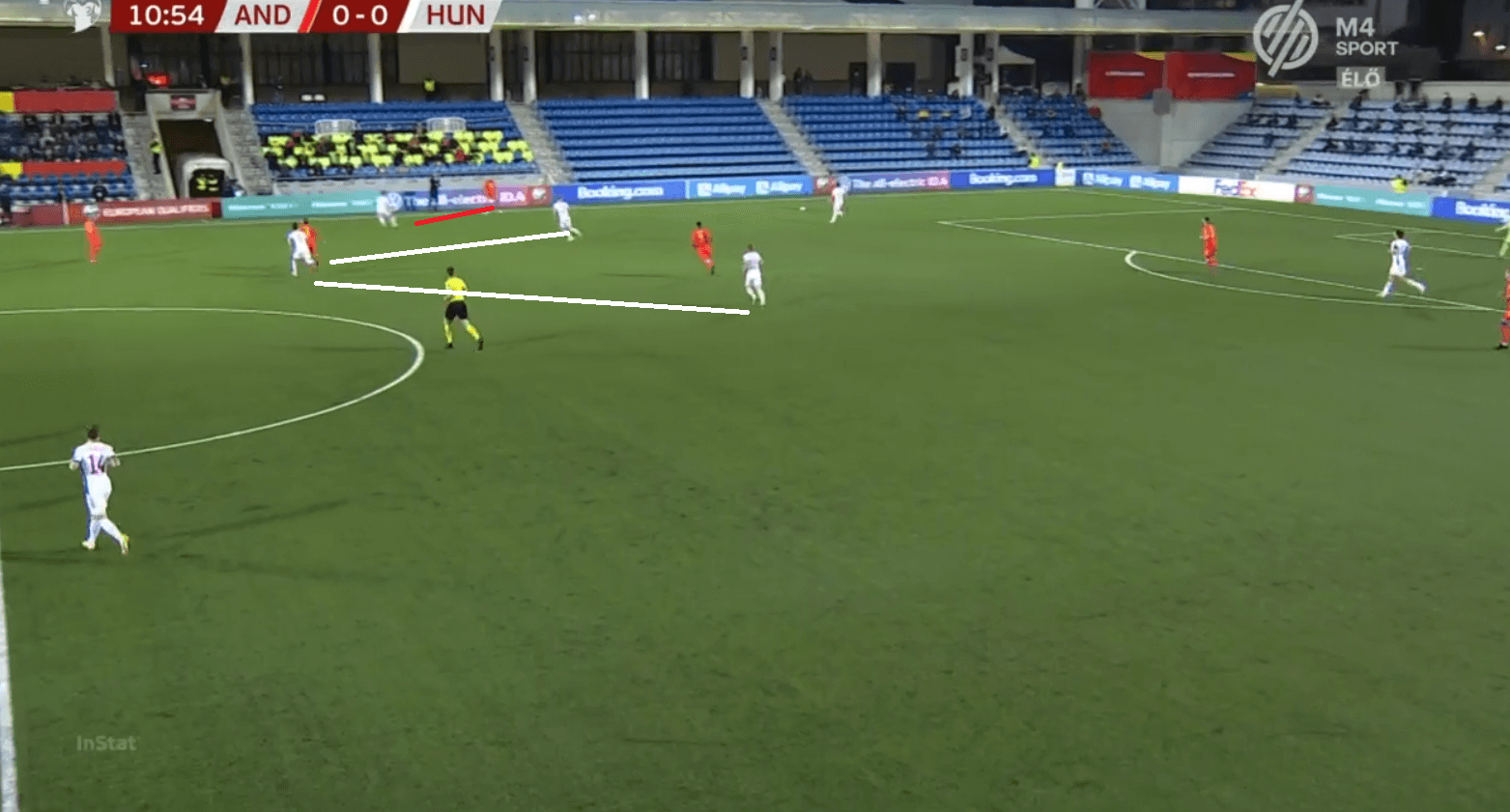
This particular match also saw them maintaining a very high line against weaker opposition. Against better opposition, they gradually stay a little deeper but mostly even that would be a mid-block like in the image below. We can see how compact they are and again look to force Poland, this time, to wide regions. When Poland looked to play over the top balls to their runners, Hungary with an extra centre-back defended well and stopped the attack.
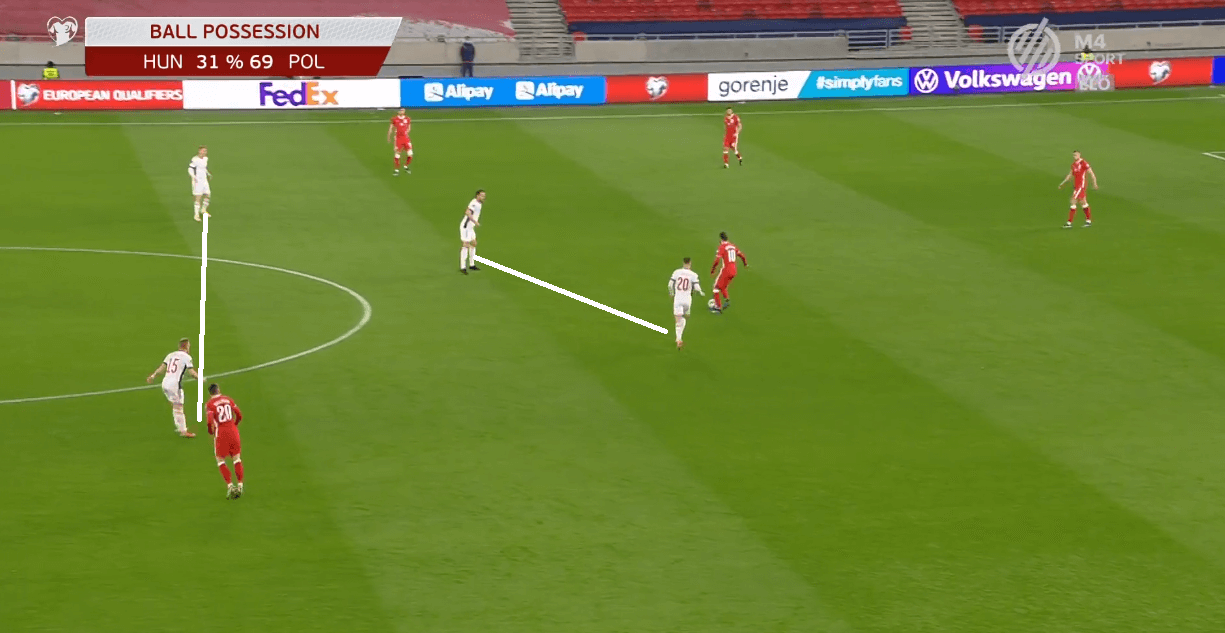
Though they are a good team defensively, they relatively faced very strong teams in the qualifications last year. The quality players within Portugal, France and Germany are at a different level when compared to the likes of Turkey, Andorra, etc. So it might be interesting to see how they are going to defend against such teams in the tournament. But the obvious thing is that they would set up much deeper than usual and sit in a low block against these teams.
TRANSITIONS
Teams that cede possession to their opponents to attain defensive solidarity on the pitch know the importance of transitions in their play. Given the overall quality of the teams in their group, Hungary are certain to be the least dominating team in their group at least in terms of possession. So counter-attacking situations are very important to them in terms of a goalscoring perspective. They are pretty much a very good team during transition from defence to attack with some good players to launch and complete it. Their game against Poland in March was one of the recent games where they set themselves out to hit their opposition during transitions.
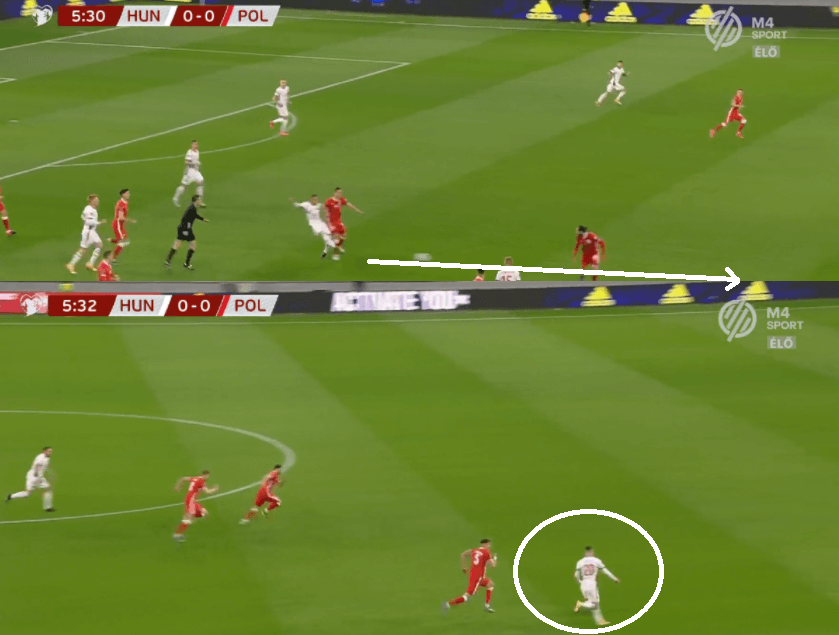
After winning the ball in their defensive third, Hungary defensive midfielder Adam Nagy immediately pings the ball to centre-forward Roland Sallai. In this situation, the entire Poland structure was disorganised with insufficient space coverage by their first two lines. Sallai made good use of the uncovered spaces and used his pace to go and score the goal for his team.
After the first goal, Hungary as expected settled in a very deep block. They committed a lot of men behind and were much more conservative. This reduced the numbers they were going to commit forward for a counter-attack which means that the opposition can easily stop the transitions with their rest defence. We can see the number of Hungary players in the box against very few Poland players.
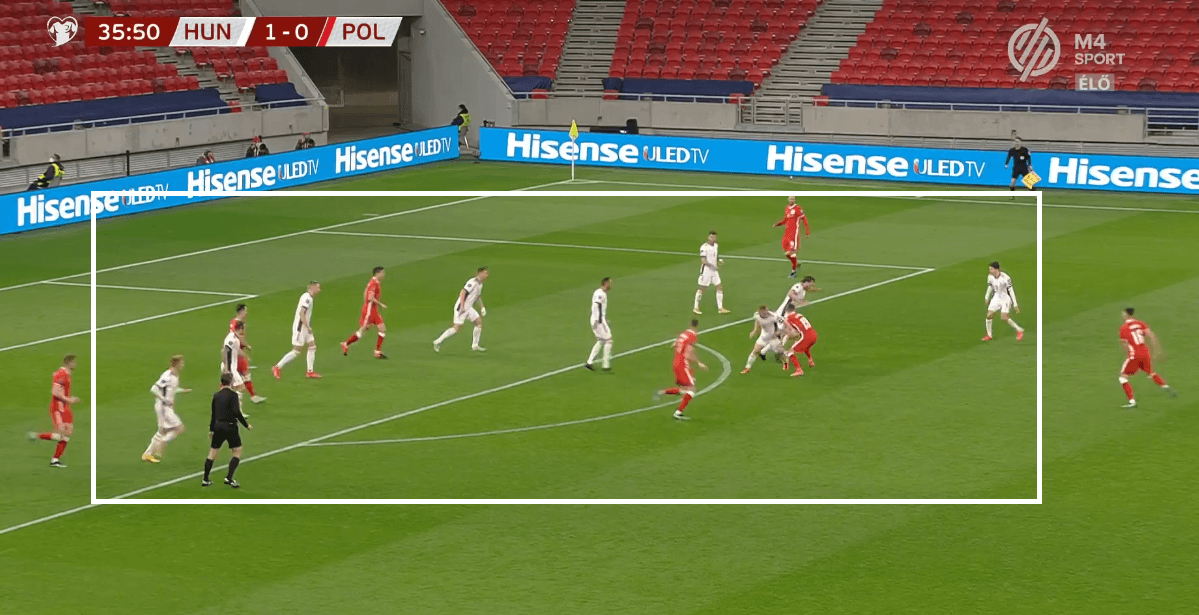
Also, the execution of actions are very important during counter-attacks. Players making the right runs and passers finding them with the right passes with precise execution are very important and Hungary must be at the top of their game in the main tournament.
In the games where they dominated possession, they did well during defensive transitions (attack to defence). Though they won’t be in these situations for 95% of the time in the tournament, this is something that still needs to be discussed. Hungary have a good knack for immediately having a large number of players tracking back during transitions. Their wing-backs are industrious and their centre-backs have a good sense of initial positioning. We can see that in the image below where Hungary have all their defenders against 3 Andorra players.
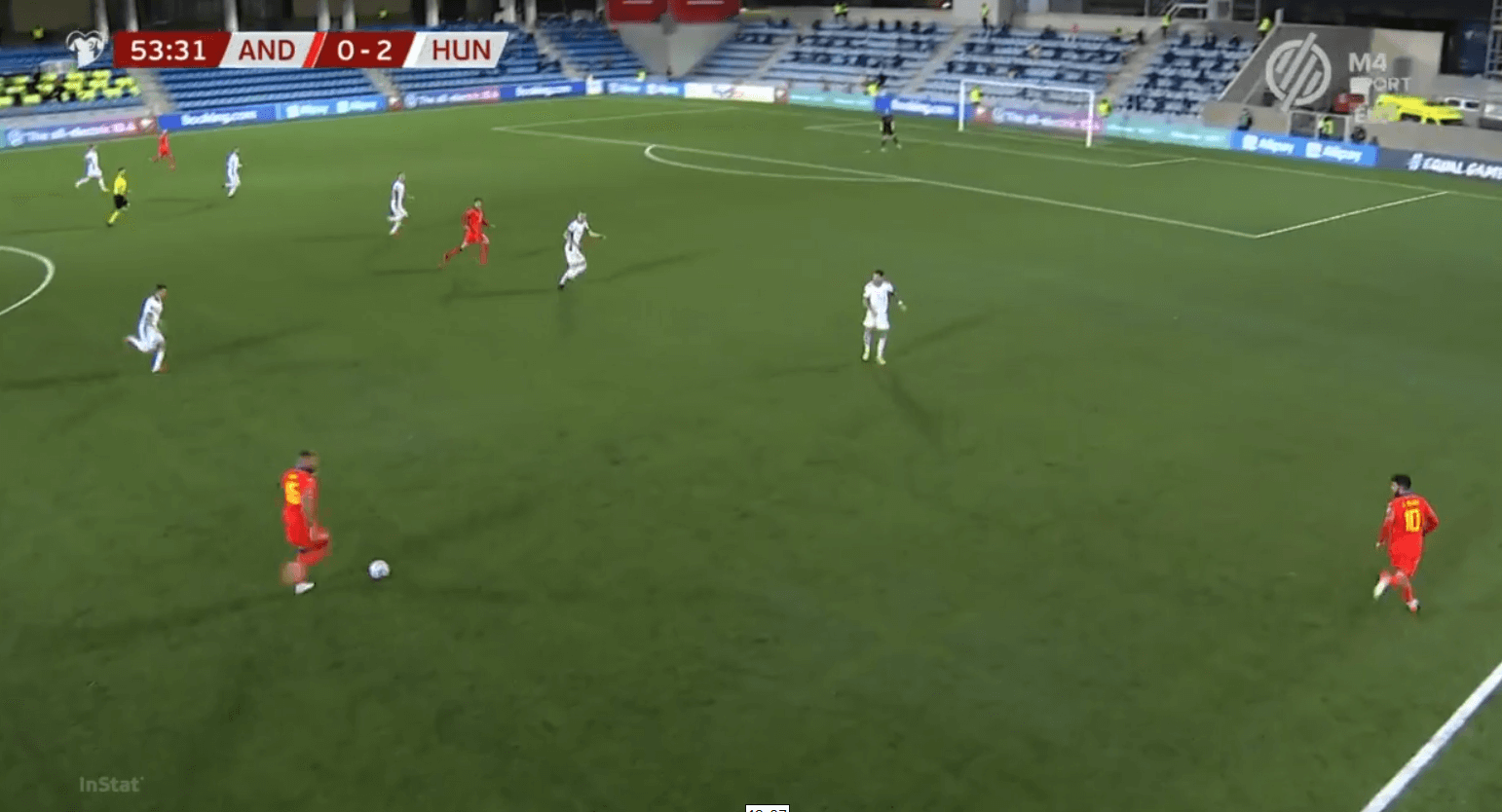
These could come in handy especially against the likes of Mbappe, Ronaldo, Werner and Sane as all these players are dangerous during counter-attacks with their pace and intelligence could be too much to handle for the defenders.
FORWARDS
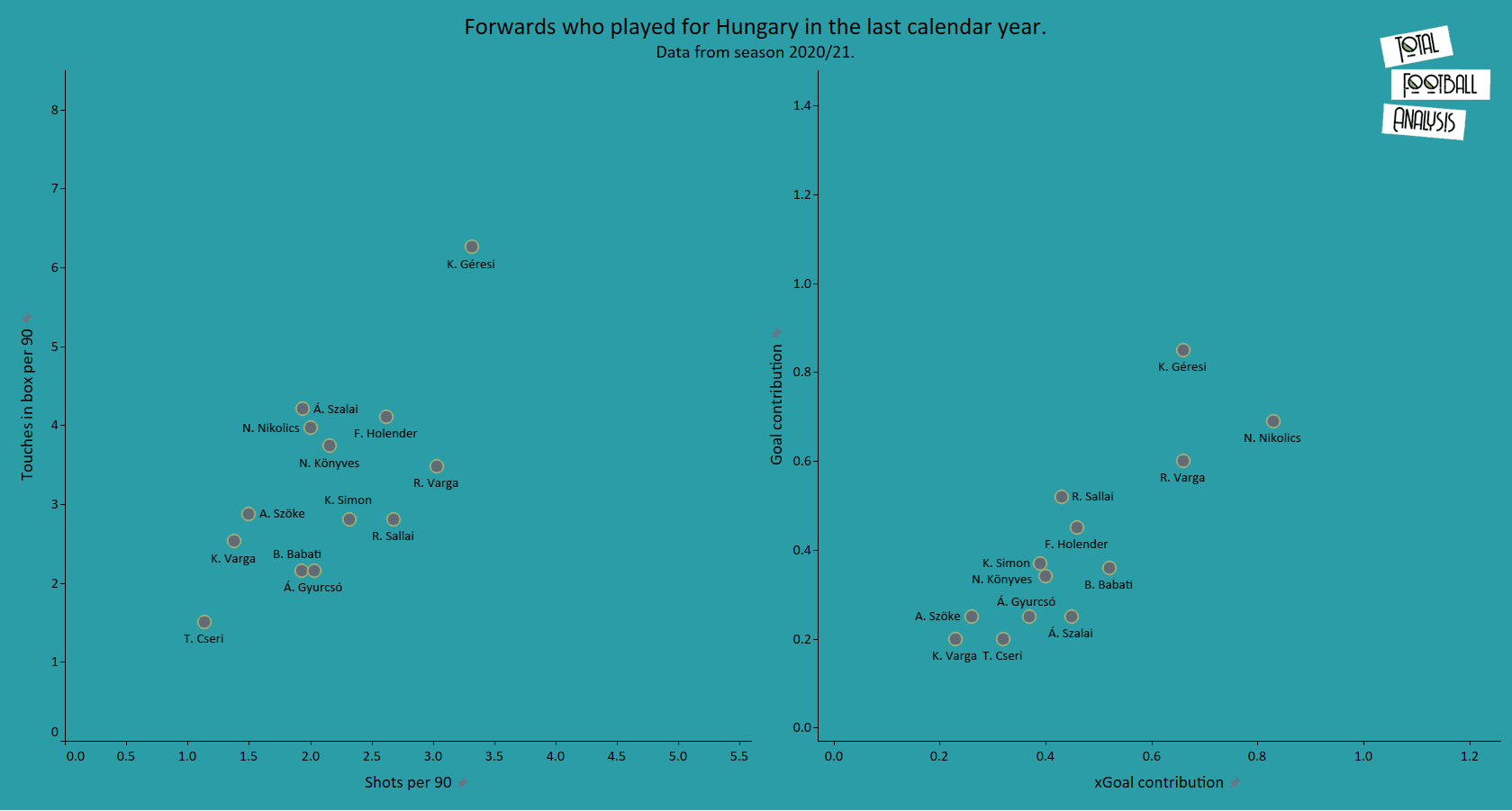
Hungary have a good amount of forwards who can represent them in Euros this year. From the veterans like Szalai and Nikolics to young guns like Roland Sallai, head coach Marco Rossi has a good amount of options in front of him. When we compare the forwards with each other we can see almost everyone seems to be having the same impact and they record almost the same statistics. We would like to ignore Geresi from this comparison as he has played just one match which has slightly skewed his statistics.
Among the rest, Szalai,ender and Nikolics have comparatively averaged more touches inside the box while taking very few shots. Whereas, Sallai and Varga have been showing much more end-product by taking more shots with fewer touches in comparison.
When we look into their goal contributions, Nikolics and Varga stand out as the best attackers statistically. We can see why Nikolics despite averaging more touches has taken fewer shots is that he gets a lot more involved in delivering the final pass. Even if he does not shoot much he seems to be making up for that by assisting shots. Sallai too seems to be good and is one of the players who has outperformed his expected contribution. This means that he can be very clinical in front of the goal. Szalai’s end product seems to be average when compared to the other attackers but he brings a lot more balance to the attack by getting himself involved in deeper plays.
MIDFIELDERS
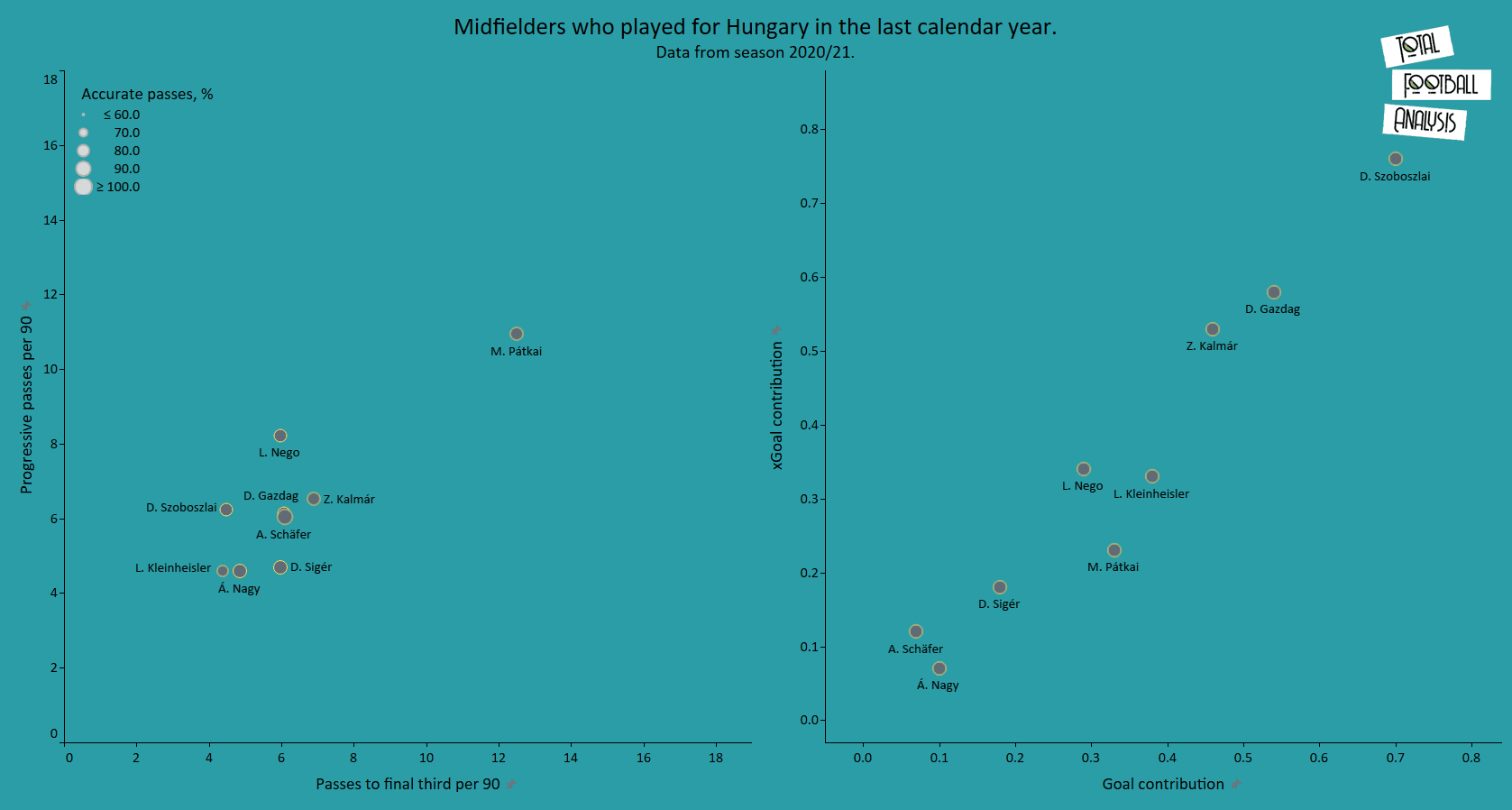
Comparing the midfielders we can see from the chart that Máté Pátkai is their best central midfielder statistically. He records more passes into the final third and progressive passes per game when compared with the other Hungary players. Though he hasn’t fared for almost a year due to his age, he still seems to be showing that he can be a valuable asset if taken on the plane.
Among the realistic players to make it to the squad, we see that Nego records more progressive passes than any other player apart from Pátkai. This is because of his style of play which means that he is much more involved after the ball has gone to the final third rather than before it. But he plays as a specialist right-back for his club and will go into the tournament as a right-back. With respect to the goal contributions, Szoboszlai is their best player and has a ridiculous amount of output when compared to the other players. The likes of Kalmar and Kelinheisler are less involved in moving the ball into the final third for their respective teams but inside the final third they record very good statistics that can be seen from their expected and actual goal contributions. Especially, Kalmar has been the best of the available pool of midfielders in terms of goal contributions. But his injury means he would not be making it into the Euros squad. Gazdag is just behind him and also is another great option for Rossi for an attacking midfield role.
Schafer is good at progressing the ball and getting it into the final third. But his contributions in front of the goal is pale when compared to Kleinheisler who seems to be the probable candidate to partner with Kalmar in the central midfield. If Rossi wants to have a more balanced midfield instead of two midfielders who are heavily involved inside the box, then Schafer could be chosen. The defensive midfield role, an important position in football, will be covered by Nagy and Siger. Both seem to be averaging the same numbers when it comes to playmaking while Siger edges out Nagy with his involvement in the final third. Regardless of that Rossi seems to be preferring Nagy due to his intelligence and ability without the ball and in Siger he has a very good back-up for the former. Overall, Hungary have extremely good options with players playing at their peak and Rossi would be expecting his midfield department to deliver at the biggest stage.
DEFENDERS
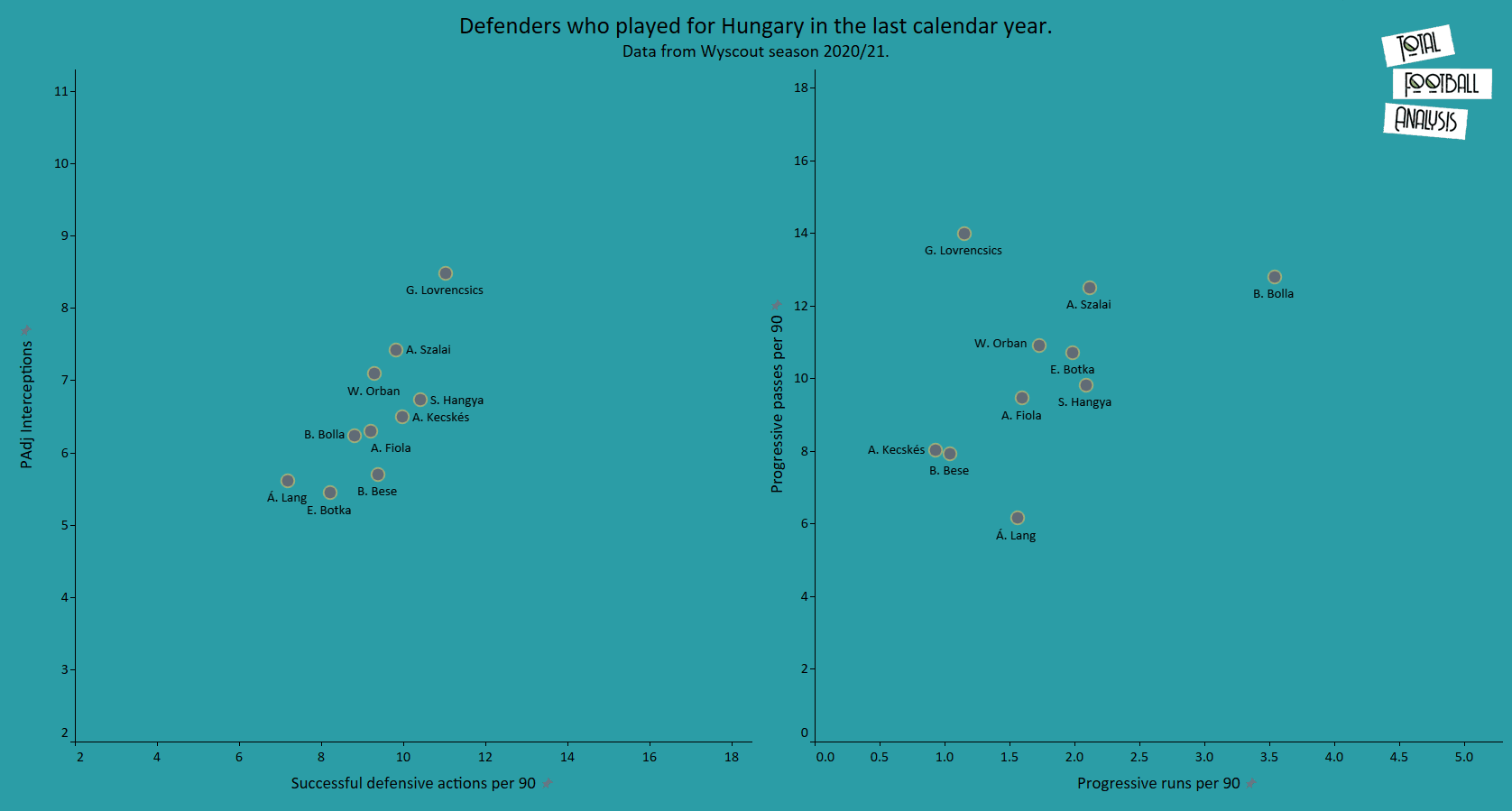
The expected starters seem to be doing well here especially in the defensive metrics. Right wing-back Lovrencsics seems to be recording the most number of interceptions (possession adjusted) and successful defensive actions per game. This speaks volumes about his reading of the game and ability to defend without possession.
For his club, he plays as a right-back and positions much deeper. So he has the defensive instincts that are required for a wing-back especially when Hungary are predominantly going to be playing in a 5-3-2 setup. Attacking wise, he plays the most amount of progressive passes among the available pool, though he is not good at doing the same while carrying the ball. The reason could be his age (32 years old) where you can no longer have the same mobility as before. His back-up, Bolla, seems to be the best-attacking full-back available as he ranks first for most progressive runs while just behind Lovrenscics in progressive passes. Rossi could also opt for Bolla as his energy can bring in a fresh dimension at the wing-back role.
His partner on the opposite side, Hangya also seems to be doing well. Though he does not average a lot of interceptions, he makes up for that with his ability to perform other defensive actions and help his team out. He seems to be a little balanced with respect to his progressive actions when compared to Lovrencsics but still behind the latter as well Bolla.
Looking at the potential starting centre-backs, we see that Szalai and Orban lead the roster when it comes to the defensive metrics as well as the offensive ones. Szalai is comfortably ahead in all 4 metrics and seems to be one of the best young defenders going into the tournament. Orban too is not very far behind as he makes a lot of progressive passes per game while he can also be a decent carrier with the ball. His importance to the team will be discussed in detail in the following section.
Fiola seems to be the best of the rest with respect to the statistics and is why we have chosen him to be the third centre-back in the starting 11.
BEST PERFORMER
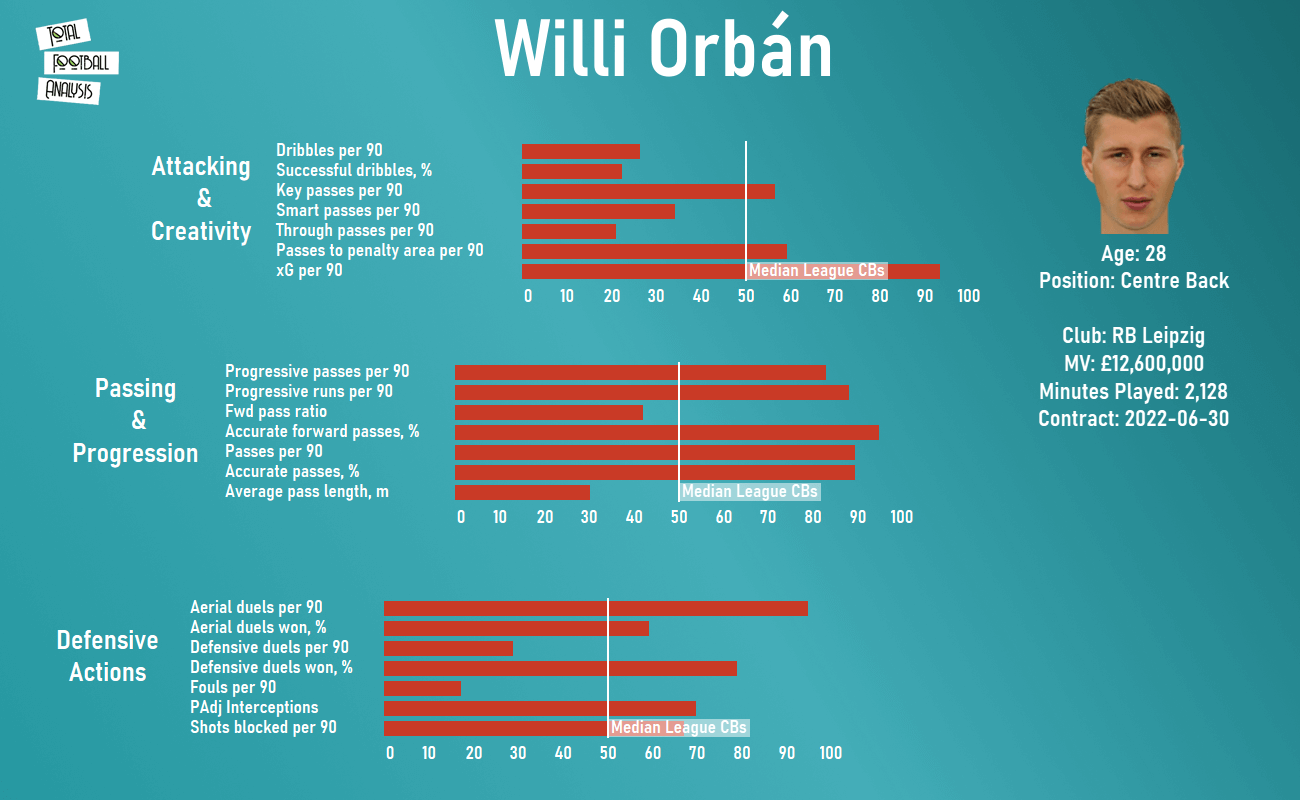
We discussed how Willi Orban’s performance might decide the fate of Hungary in their group of death. The statistics here prove why he is probably their best player going into the tournament. He is their high profile player as he represents one of the best clubs in Bundesliga and Europe, RB Leipzig.
Julian Nagelsmann’s side have been the best team in the 2020-21 Bundesliga, conceding the least number of goals. The core central defenders part of their backline include Orban, Bayern Munich bound Dayot Upamecano and Liverpool bound Ibrahim Konate. Despite a dip in the performances of the latter two, Leipzig have been successful defensively which is mostly down to Willi Orban’s extraordinary performances for the club this season. Experts around the world also agree on the fact that he has been their best defender this season.
We can see from the chart that Orban ranks around the 95th percentile for aerial duels contested per game and his success rate is also above the league average. Unlike his French partners, he is not very aggressive in his challenges which can be seen in the number of defensive duels on average he has contested per game. His style is to delay the attackers’ actions by staying tight to them with the right body orientation and reading their next actions. This is the reason why he records a lot of interceptions per game (possession adjusted) and has also blocked a lot of shots (ranks above 70th percentile in both). He can also be reactive and is capable of performing last-minute challenges in a situation where they have been caught out. This balanced defending means that Leipzig concedes very few spaces behind their opponents.
Like every other modern-day defender, Orban is also extremely good and valuable on the ball. He is among the players responsible for helping Leipzig play out from the back. He ranks around 90th percentile in both passes attempted per game and passing accuracy. His forward pass ratio suggests most of his passes are lateral and are much more oriented towards retaining possession, he still completes a lot of forward passes with great accuracy. This can be seen from his progressive passing stats as he is one of the best defenders in progressing the ball up the pitch. His average pass length suggests that most of his progressive passes are line breaking short passes which also adds a lot of value to the team from an offensive perspective.
Along with that, he is also a high volume carrier with the ball and makes a lot of progressive runs with it. Playing in a back-3 means most of Leipzig’s opponents press with a 2-men forward line, giving Leipzig’s backline a 3v2 advantage. Orban, who starts at the left centre-back position, is given the opportunity and time to progress the ball in the half-space.
His involvement on the ball can also be seen in the final third where he ranks above league average with respect to the number of passes into the penalty area and key passes. He possesses a good ability to break defence with these passes and find runners in good spaces. He is also a dangerous threat during set-piece situations as he is one of the main targets for both club and country during those. This is one of the reasons why he has taken a lot of shots and we can see his xG per game is at the 96th percentile rank among league defenders.
Despite Hungary having much more experienced players, Orban will be their most impactful player going into the tournament with Champions league level playing experience. Hungary’s chances of progressing are going to be less but Orban could greatly inspire them and can be a deciding factor if they manage to pull some upsets out of the bag in the tournament.
PREDICTIONS FOR THE TOURNAMENT
Hungary faces the daunting task of playing against very good teams and world-class players. Though they have some very good players and some underrated ones in their squad, it would be very tough for them to compete against the likes of France, Portugal and Germany. They are surely the underdogs in their group and they need to punch above their weight to have a chance of qualification to the knockout stages. We expect them to finish 4th in their group and if they do qualify it would be from one of those 3rd place spots.

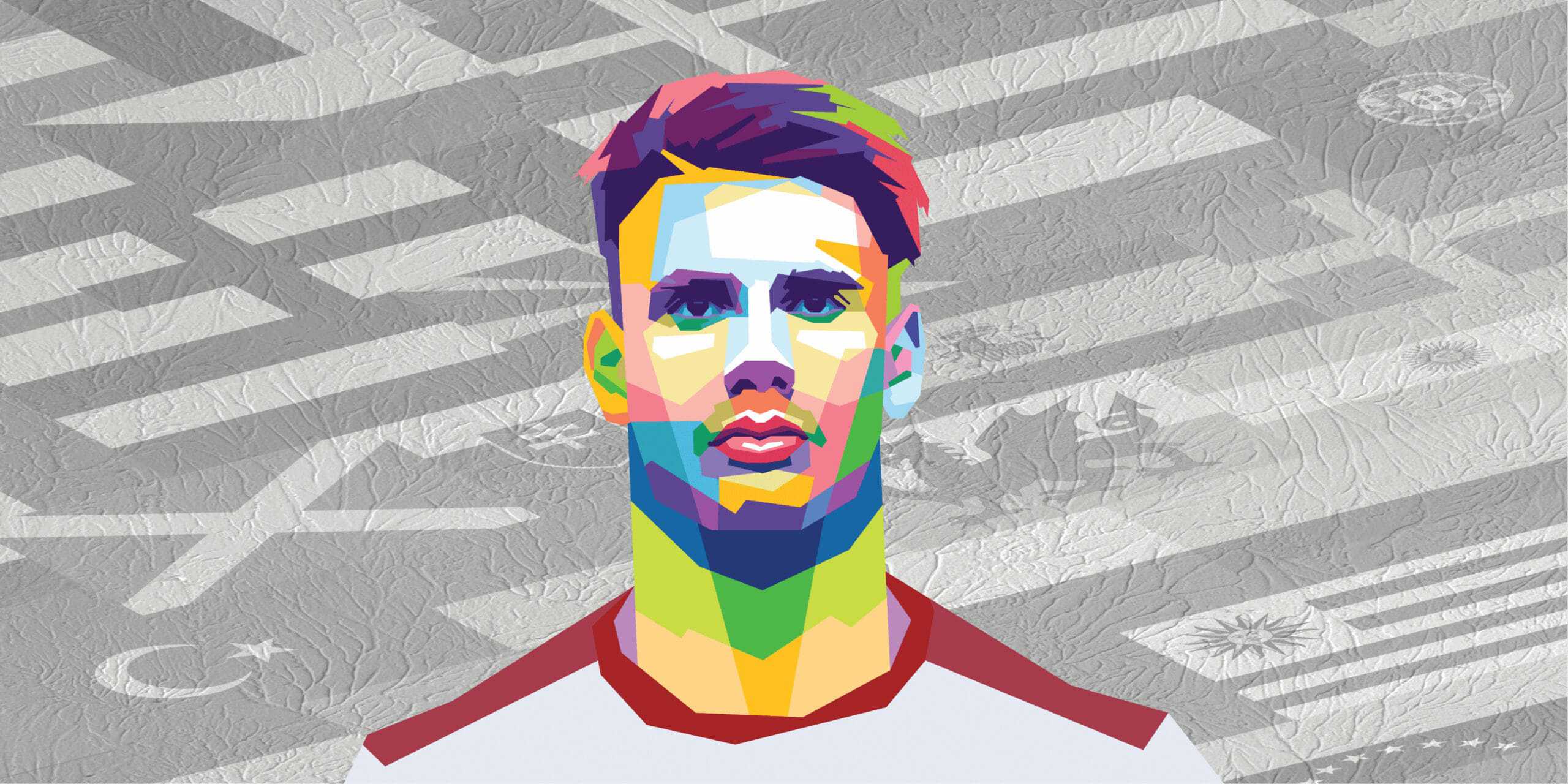




Comments